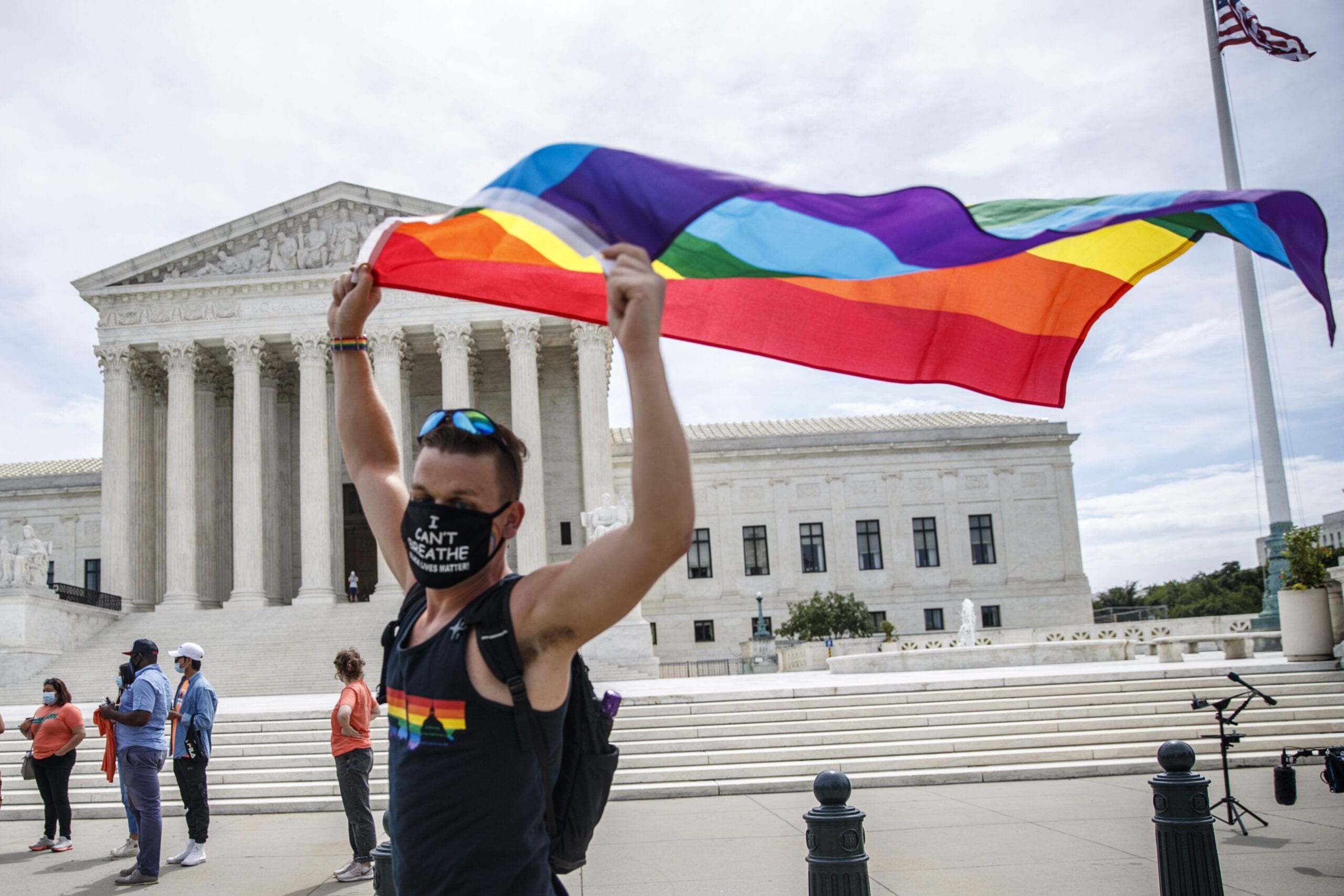On June 15, the Supreme Court of the United States ruled that discrimination against employees who are queer and trans violates federal employment protection law. But the fight leading up to Monday’s landmark LGBTQ2 rights ruling began long ago in the U.S. One battle in particular sticks out: In 1991, three same-sex couples were seeking the right to marry in Hawaii. They were turned down by the state, and again by Lambda Legal when they sought help to challenge Hawaii through the courts. Moving forward with their own attorney, the couples brought suit against the state director of health in Baehr v. Lewin (later Baehr v. Miike). A trial court dismissed the case, but the couples persevered. Eventually, they landed in the Supreme Court of Hawaii, which sent them back to trial court.
On Dec. 3, 1996, the judge determined that a marriage ban couldn’t pass the applicable legal standard for policies targeting a group on the basis of sex. Namely, Hawaii failed to establish some compelling state interest in preventing same-sex marriage, much less prove that a ban would be the most “narrowly drawn” means of achieving its goals. The trial judge ordered the state to provide marriage licences to same-sex couples, but stayed his ruling—anticipating that if couples married on the strength of the trial court’s decision only for the Hawaii Supreme Court to overturn it, they’d find themselves in limbo. Twenty-three months later, to the day, Hawaiians closed the issue by voting to amend the state constitution to allow the legislature “to reserve marriage to opposite-sex couples,” killing the plaintiffs’ case.
What followed was a schism within the LGBTQ2 community—specifically, within the LGBTQ2 legal community and among allies—around priorities and strategies for securing legal protections. Optics were one issue; feasibility, another. Some wanted to focus on marriage. Others wanted to fight for protections on the basis of sexual orientation and gender identity under the banner of sex discrimination.
Progress was stymied first by “Don’t Ask, Don’t Tell,” lasting from 1994 to 2011 and forcing LGBTQ2 members of the military to remain in the closet or leave the armed forces. Then there was the Defense of Marriage Act, restricting marriage to opposite-sex couples from 1996 until 2013. Ultimately, progress-wise, marriage proponents would succeed first with Obergefell v. Hodges legalizing same-sex marriage in 2015. But nothing’s zero sum: Activists and litigators had forged ahead on a parallel track, pushing for non-discrimination and winning victories at the state and even federal level through administrative means.
And so, 30 years after Baehr, with Monday’s decision in Bostock v. Clayton County, Georgia, we’re on the cusp of having both.
Hitching sexual orientation and gender identity to sex discrimination has always been the dream solution, the neatest path to securing robust legal protections for LGBTQ2 communities, if not the sexiest or easiest elevator pitch. Marriage was, of course, much more telegenic: A perfect case of showing rather than telling. Fighting for everyday rights has always been more complicated. There have been false starts along the way—like the Employment Non-Discrimination Act (ENDA), introduced in every Congress since 1994, save one. And, of course, ENDA wouldn’t even necessarily include protections for transgender people. While the Equality Act, passed by the House of Representatives in 2019, would accomplish far more—extending protections for LGBTQ2 Americans in everything from housing and credit to education and federal protection—it, too, has stalled, passed by the House but locked in the Senate since May 2019.
“The Supreme Court opinion in Monday’s case gives us a starting point for plugging sexual orientation and gender identity into the canon of law governing discrimination on the basis of sex”
The courts remain the key. Monday’s decision is the denouement of a saga of circuit court cases taking on Title VII, the workplace non-discrimination provision of the Civil Rights Act of 1964. These cases have been wending their way through the federal courts for several years now, resulting in a split. The Second and Sixth Circuits found that Title VII bars discrimination on the basis of sexual orientation. The Eleventh Circuit (for context, that’s Alabama, Florida and Georgia) not so much.
It was a matter of time before the Supreme Court took up the question of Title VII vis-à-vis sexual orientation, which it could have done without ruling on gender identity. On Mar. 24, 2017, I wrote a column for the Center for American Progress gloomily forecasting that Trump-nominated Justice Neil Gorsuch would be the end of gay rights. Senator Jeff Merkley even read the column aloud during his 15-hour filibuster against Gorsuch’s confirmation.
I’ve never been happier to be wrong.
The Supreme Court opinion in Monday’s Title VII case, Bostock v. Clayton County, Georgia—written by none other than Justice Gorsuch—leaps beyond what ENDA might have given us and, better yet, gives us a starting point for plugging sexual orientation and gender identity into the canon of law governing discrimination on the basis of sex. The implications are terrific.
It is far better to be seen and incorporated into existing law, as this decision does—and as the Equality Act would—than to carve out some new category. That alternative—segregating gay, lesbian, bisexual and trans people by reducing our identities to choices and actions, the type of sex we choose to have and with whom, how we realize our gender identity—would have left LGBTQ2 people vulnerable to legal shenanigans. Far better to acknowledge sexual orientation and gender identity as the characteristics of a community of people within the U.S. population entitled to the same protections that other protected classes enjoy.
“Thorny debates lie ahead: It remains to be seen whether LGBTQ2 people qualify for a higher degree of protection”
Thorny debates lie ahead: It remains to be seen whether LGBTQ2 people qualify for a higher degree of protection. Women are protected as a quasi-suspect class, meaning actions and legislation that target them merits intermediate scrutiny. That’s the standard from Baehr that asks only if a law fulfills a compelling state interest and is narrowly tailored to achieve the state’s legitimate aim. For queer and trans folks, the argument for heightened protections goes like this: LGBTQ2 people are subject to additional threats and burdens; sexual orientation and transgender identity should be considered a “suspect class” because they meet the criteria that define groups protected by “strict scrutiny,” another legal term of art. Those criteria include historic discrimination based on an immutable trait, disenfranchisement in the political process and an otherwise unhampered ability to contribute meaningfully to society. Right now, suspect classifications—those presumed illegitimate as a means of drawing distinctions in law—consist of race, national origin and alienage or citizenship. Monday’s decision does not suggest sexual orientation or transgender identity will join the ranks of suspect classes. Neither does it foreclose the possibility.
We must be clear about what Bostock accomplishes, and what it does not, particularly in this explicitly hostile federal climate. The case applies to the workplace only: It doesn’t protect LGBTQ2 people from being discriminated against by businesses as consumers, in public accommodations, housing, federal programs and so on. It does not necessarily strike down Trump’s trans military ban, though it will likely fall as a result. This ruling could also provide grounds for challenging this administration’s anti-LGBTQ2 rule-making projects, like its recent move to excise Health and Human Services protections for LGBTQ2 people in health care.
There’s also the tension, which Gorsuch previews, between conservatives’ weaponization of “religious liberty,” a pretext for justifying affirmative discrimination against LGBTQ2 people, and burgeoning protections on the basis of sexual orientation and gender identity. “How these doctrines protecting religious liberty interact with Title VII are questions for future cases,” Gorsuch writes. The opinion does nothing to resolve this conflict, only teases that it lies ahead.
Without a doubt, Monday’s decision is an important step forward. But it’s also a warning that much work is left to do—and of how critical that work is.


 Why you can trust Xtra
Why you can trust Xtra


